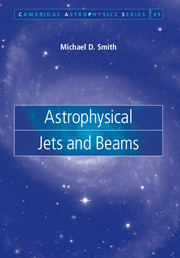Book contents
- Frontmatter
- Contents
- Preface
- 1 Introduction
- 2 Detection and measurement
- 3 The dynamical toolbox
- 4 Observations of extragalactic jets
- 5 Jets in galactic nuclei
- 6 Jets from young stars and protostars
- 7 Jets associated with evolved stars
- 8 Jets within the solar system
- 9 Jet launching
- 10 Jet propagation
- 11 The astrophysical jet
- References
- Index
8 - Jets within the solar system
Published online by Cambridge University Press: 05 March 2012
- Frontmatter
- Contents
- Preface
- 1 Introduction
- 2 Detection and measurement
- 3 The dynamical toolbox
- 4 Observations of extragalactic jets
- 5 Jets in galactic nuclei
- 6 Jets from young stars and protostars
- 7 Jets associated with evolved stars
- 8 Jets within the solar system
- 9 Jet launching
- 10 Jet propagation
- 11 The astrophysical jet
- References
- Index
Summary
We have learnt about nearby jets by going out to meet comets as they come in to visit our neighbourhood. Jets of gas and dust appear as comets approach the Sun. Since Vega and Giotto's rendezvous with Halley in 1986, we have known that the jets are generated from within the nucleus of a comet, and that the nucleus is only a few misshapen kilometres of low-density ice and rock. Such jets change the trajectory of a comet, providing a rocket effect, which alters the comet orbit. In addition, mass loss through jets produces the spiral and shell structures seen in the comae and proceed to supply the tails. The mass loss also implies that several metres depth of material is lost from an active region per orbit around the Sun.
Our capability for close encounters has resulted in the only resolved images of the launching regions of astrophysical jets. Here, we first synthesise the observations of cometary jets and establish their properties. In Chapter 9, we will see how the probable launch mechanism compares with other models.
Solar jets have also come into prominence in the last decade through high-resolution satellite imaging. On all scales, from spicules to coronal jets, the Sun displays a bewildering array of jet-like phenomena. The uniting factor is that they are magnetically rooted in the photosphere. Some propagate into the chromosphere, while others shoot up into the corona. Apart from exploiting the same energy source, they really have nothing to do with cometary jets. Rather, being magnetically mediated, the physics is relevant to more distant jets although the obligatory accretion disc is missing.
- Type
- Chapter
- Information
- Astrophysical Jets and Beams , pp. 144 - 156Publisher: Cambridge University PressPrint publication year: 2012



